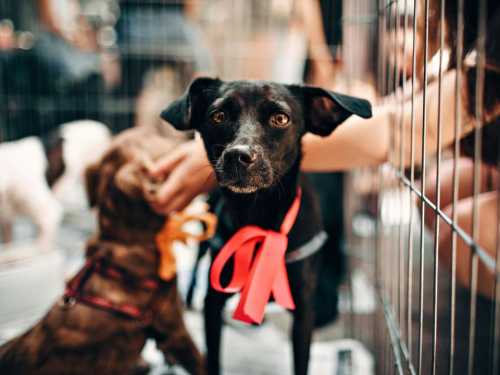
What to do if a dog refuses to obey and starts showing aggression and fear?
I remembered an old joke about odds. What are the chances of seeing a dinosaur if you look out the window in the morning? It's always 50/50: you either see it or you don't. It's the same with dogs.
If you want a more definitive answer to this question, then unfortunately it is not up to me. I cannot predict the probability of an individual dog accepting an individual person. Therefore, it is always 50/50 — either he will accept or not, more about that here.
Many dogs settle into a new family, others don't. I know that if you want to, with or without outside help, you can overcome almost anything in the world. Almost. Doubting yourself? Then don't tempt fate: your time has not come yet. A dog-rejecter needs a home, not a stopover “for a try.”
One thing is certain: the dog will definitely be worried. No one likes change. There is no doubt that at some point the new owner will have difficulties in their relationship with the dog, some even in the form of open conflicts. And the question here is not how likely they will be, but how prepared the person is for them.
During the time it lived before it appeared in your family, the dog has gained a very extensive baggage of experience. There is the influence of the environment, and mistakes in upbringing, and some fears, and bad habits. What was there – no one knows. Even if in a past life the dog was bathed in love, and the previous owners were so responsible that they worked well on shaping its behavior, the rules by which that house lived are probably different from those adopted in your family. This is enough for the dog's habits to begin to cause irritation, which is very difficult to cope with.
Be prepared for difficulties
A change of environment can have a positive effect on the dog's behavior, which means that there is a possibility that you will be able to cope with problems that seemed insoluble to the previous owners. However, both a favorable and unfavorable outcome of the dog's relocation will be equally likely. You can take a dog of any age, but only on the condition of a clear understanding that the older the dog, the more difficult it will be to integrate into your family. The richer its life experience, the more pitfalls it may have.
How can you find out more about a dog's history?
Be sure to ask the current owners or curators at what age the dog was taken to the shelter, how many times it has changed owners since then, and why it was abandoned. Pay attention to the presence of acute or chronic diseases, injuries, and the consequences of operations. Clarify and ask again: as practice shows, much in the story about the dog, such as allergies in one of the family members, turns out to be untrue. This is not necessarily due to malicious intent, since it is not always possible to reliably find out how the dog lived before. However, cases of outright lies also occur.
Carefully assess the situation in the house where the dog lived.
The opportunity to take a dog from its original owners is a great blessing. The animal has not yet developed a bitter aftertaste from changing families, and you can hear its story firsthand. By the way, fresh traces of damage on furniture, walls or furnishings or the characteristic smell of dog feces will give you the most accurate idea of why the dogs decided to get rid of them. Discuss your observations with the owners and ask if there are any behavioral problems in the dog that you should be aware of.
Visit the dog several times
At the first meeting, the dog will most likely behave in a restrained manner, which may give you a wrong idea about its character and temperament. The ideal option is to talk to the dog several times at least during the week. Be patient and let the animal open up. Only then, having weighed all the pros and cons, will you be able to make the right decision, and therefore not add another episode of moving to another place to the dog's experience. It needs help, not spit in the soul.
Be sure to take your dog for a walk.
If circumstances allow and the curator or owner allows, walk the dog face to face for at least half an hour. Walk with it down the street, go to the park and go to the nearest shopping center. See how the dog treats other animals, children, people around him and city noise. Assess how ready he is to make contact with you, whether he agrees to follow basic commands and accept treats from you. A dog is unlikely to change instantly when moving to a new family. Remember that it will take time for you to change problem behavior and do not expect that the situation will change instantly after moving to a new family.
Try to attract the dog to you
Treats are a necessary (but not sufficient) condition for establishing friendly relations with a dog. Stock up on treats, having previously clarified with the curators possible contraindications. Low-fat cheese, boiled sausage or pieces of meat are most often win-win options. Offer the delicacy as if by chance, speak calmly, move smoothly. Try to avoid tactile caresses – especially if the dog has changed owners several times or suffered from beatings. Wait until it decides to approach you. This is a signal that the dog is interested in you, and it decides whether it can trust you.
Give your dog time to adjust to the new home.
Let's say you decide to take your dog. It doesn't matter how well-considered your choice was – in any case, you understand what is happening much better than the dog. Look at the situation through its eyes: it has left its familiar place and is going into the unknown with barely familiar creatures. A dog experiences stress regardless of what its life has been like up to this point. A new home means new rules, and communicating with new people requires caution. If you wish your dog well, give it peace and quiet upon arrival home, giving it free access to water and food. Do not impose your company on it. It takes a dog from several hours to several days to come to its senses and assess the situation.
Observe your dog's behavior
The dog opens up within one or two months. Do you think that only puppies gnaw furniture and howl in the absence of their owners? You have every chance of seeing the opposite. Do you think that the chosen dog is not characterized by aggression? I would still try to avoid sharp corners at first. Did you think that the dog got along well with the child? Note that it could simply be shy and did not dare to express dissatisfaction. If you notice a problem, do not panic, but contact a specialist. This will be the best for everyone.
Be an adult.
To me, being an adult means being able to soberly assess the consequences of your decisions. The dog you adopt from a shelter will probably not be like any of your previous ones. Being a well-formed personality, it is unlikely to agree to conform to the image you have drawn for yourself. Try to drive it into a framework, and it will quickly show that you and your family are not great benefactors, but for now just a stop on the way.





